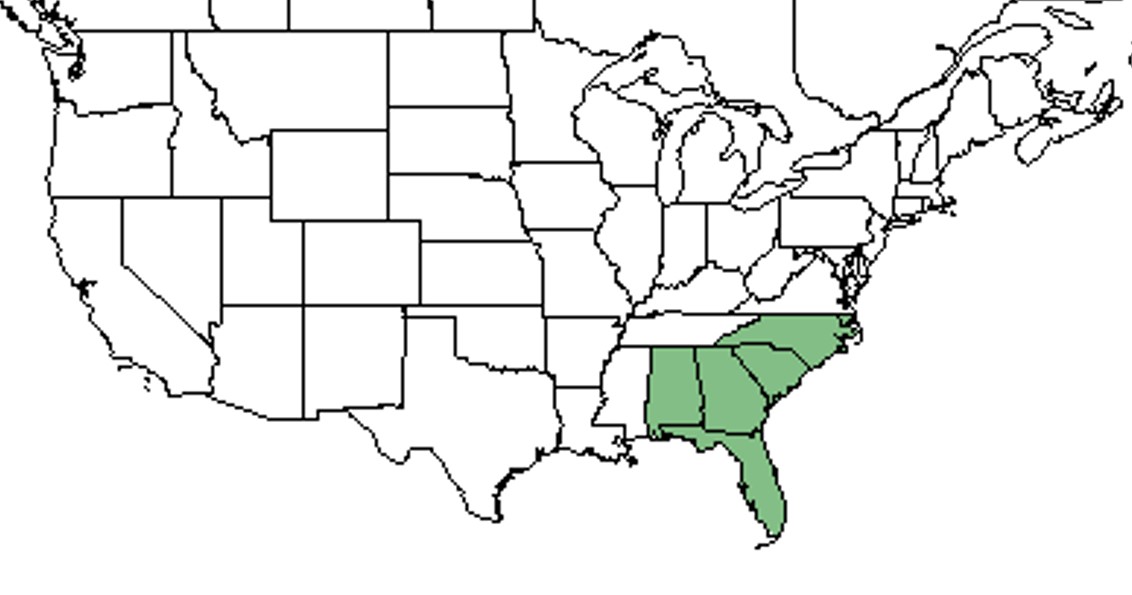Hypericum tenuifolium
| Hypericum tenuifolium | |
|---|---|

| |
| Scientific classification | |
| Kingdom: | Plantae |
| Division: | Magnoliophyta - Flowering plants |
| Class: | Magnoliopsida - Dicotyledons |
| Order: | Theales |
| Family: | Clusiaceae ⁄ Guttiferae |
| Genus: | Hypericum |
| Species: | H. tenuifolium |
| Binomial name | |
| Hypericum tenuifolium Pursh | |

| |
| Natural range of Hypericum tenuifolium from USDA NRCS Plants Database. | |
Common name: Atlantic St. Johnswort
Contents
Taxonomic notes
Description
H. tenuifolium is a short lived perennial herb that can reach heights of 12 to 18 inches. Stems are reddish brown and are covered with short needle-like shiny deep green leaves [1]. The flowers have 5 yellow petals, 5 persistent sepals, a superior ovary, and are bisexual and radially symmetrical [2]. A distinctive characteristic of this species is the long capsule, ranging from 6 to 9 mmm long [3].
Distribution
Ecology
Habitat
This species is found in dry, sandy, open sites with good drainage such as sandy woods, dunes and dune hollows, lowland and coastal areas [4]. It is drought tolerant, however does not favor well in soils that remain wet for extended periods[1]. Associated species include Polygonella polygama, Pinus palustris and Paronychia chartacea (FSU Herbarium).
Phenology
Flowering occurs during late spring and early summer with more than a dozen flowers open at any time [1]. Flowers are yellow and aromatic with the fruit capsule ranging from 6 to 9 mm in length[5].
Seed dispersal
Seed bank and germination
Fire ecology
Pollination
The following Hymenoptera families and species were observed visiting flowers of Hypericum tenuifolium at Archbold Biological Station (Deyrup 2015):
Apidae: Apis mellifera, Bombus griseocollis, B. impatiens
Colletidae: Colletes distinctus, C. productus, C. sp. A, Hylaeus confluens
Halictidae: Augochlorella aurata, A. gratiosa, Augochloropsis anonyma, A. metallica, A. sumptuosa, Lasioglossum miniatulus, L. nymphalis, L. placidensis, L. tamiamensis
Megachilidae: Anthidiellum perplexum, Dianthidium floridiense, Megachile albitarsis, M. brevis pseudobrevis, M. rugifrons
Use by animals
Diseases and parasites
Conservation and Management
Cultivation and restoration
Photo Gallery
References and notes
Deyrup, M.A. and N.D. 2015. Database of observations of Hymenoptera visitations to flowers of plants on Archbold Biological Station, Florida, USA.
Florida State University Robert K. Godfrey Herbarium database. URL: http://herbarium.bio.fsu.edu. Last accessed: October 2015. Collectors: Loran C. Anderson, Wilson Baker, Ann Johnson. States and Counties: Florida: Bay. Compiled by Tall Timbers Research Station and Land Conservancy.